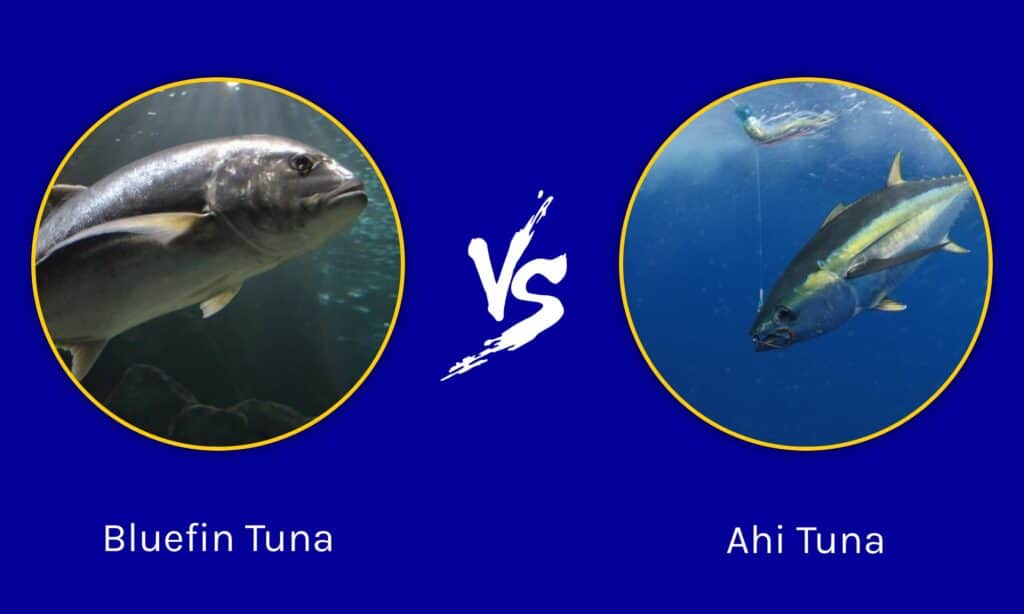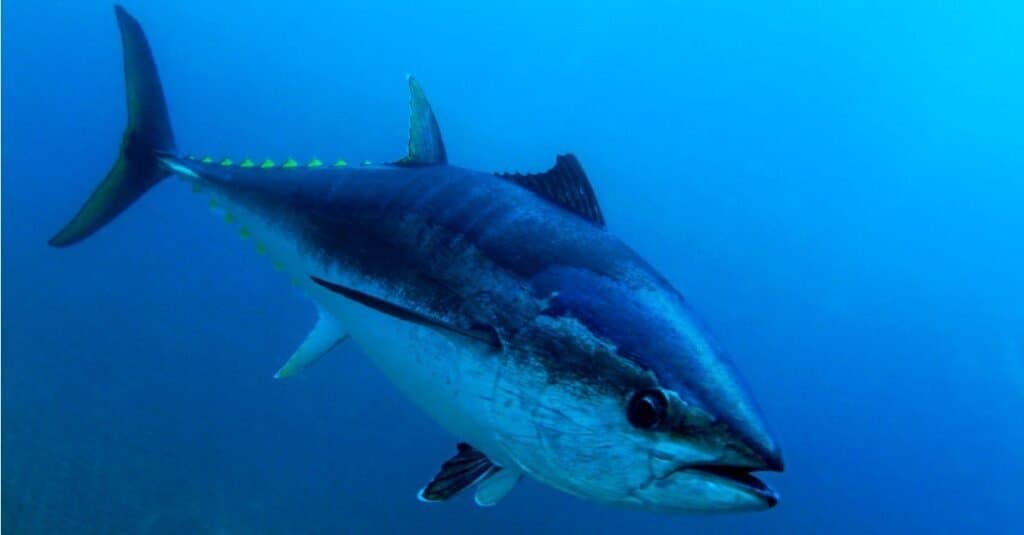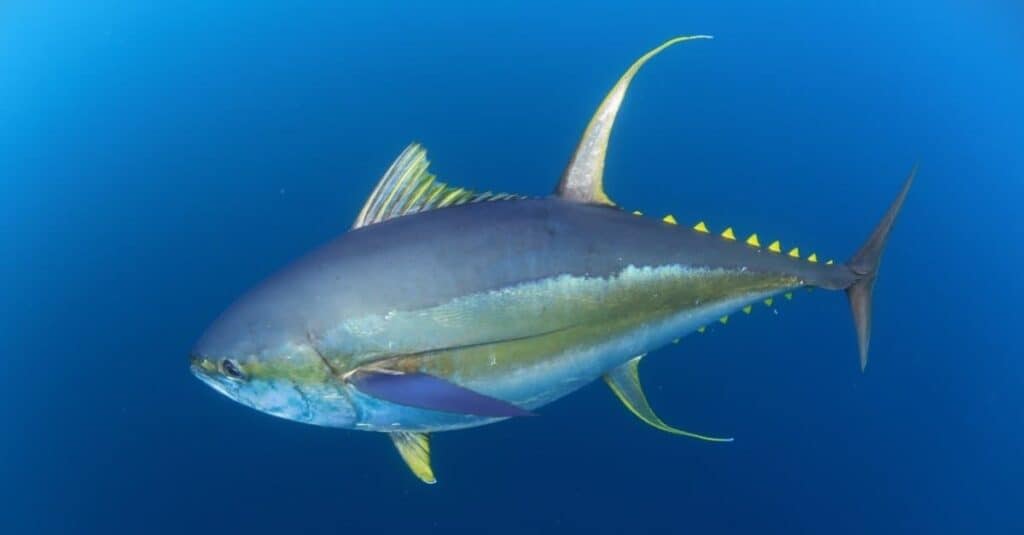Tuna are some of the most incredibly stunning and powerful fish in the world. With their torpedo-shaped bodies built for speed, some species can even reach 47mph – making them hugely popular with sport fishing. However, they are incredibly popular with commercial fishermen, as their meat is highly sought after worldwide. Two of the best-known types of tuna are bluefin tuna and ahi tuna, and at first glance, they can look extremely similar. However, they are very different fish, and luckily, there are some key differences that we can use to tell them apart. So join us as we discover everything you need to know about ahi tuna vs bluefin tuna!
Comparing Bluefin Tuna vs Ahi Tuna

Ahi tuna and bluefin tuna are not just single species of tuna. Instead, ahi tuna is the common name given to yellowfin (Thunnus albacares) and bigeye tuna (Thunnus obesus). Additionally, there are three species of bluefin tuna – Atlantic (Thunnus thynnus), Southern (Thunnus maccoyii), and Pacific (Thunnus orientalis).
| Bluefin Tuna | Ahi Tuna | |
|---|---|---|
| Location | Pacific bluefin – northern Pacific, migrates to southern Atlantic bluefin – western and eastern Atlantic, Mediterranean Sea Southern bluefin – southern hemisphere waters of all oceans | All tropical, sub-tropical, and temperate oceans |
| Water Depth | Up to 3,300 feet | Typically up to 1,640 feet |
| Size | Length – up to 12 feet Weight – up to 1,500 pounds | Length – up to 8 feet Weight – up to approx 440 pounds |
| Appearance | Heavy body, dark blue back, silver or white lower sides and belly. White lines and spots on underside. Second dorsal fin dark colored. Blue tail fin | Blue back and upper sides, white belly and lower sides. Yellow lateral line above pectoral fins. Yellow anal fins and second dorsal. Finlets and tail fin largely yellow |
| Pectoral Fins | Short – ends before the second dorsal fin | Long – often extend beyond second dorsal fin |
| Diet | Fish (mackerel, herring, sardines, anchovies, smaller tuna), jellyfish, octopus, crabs, squid, crustaceans, eels | Fish, crustaceans, squid |
| Predators | Orcas, pilot whales, sharks | Sharks (especially great whites & makos), whales, larger tuna, marlin, wahoo, billfish |
| Lifespan | 40 years | 15 years (bigeye), 7 years (yellowfin) |
The 4 Key Differences Between Ahi Tuna and Bluefin Tuna
Ahi Tuna vs Bluefin Tuna: Size

Bluefin tuna are huge fish and can reach an incredible 1,500 pounds and 12 feet long!
©iStock.com/Whitepointer
One of the most noticeable differences between bluefin and ahi tuna is their size. Ahi tuna can reach up to 8 feet long and 440 pounds, with both yellowfin and bigeye tuna being of a similar size. However, ahi tuna are generally much smaller than bluefin tuna. On average, all three bluefin species are larger than ahi tuna. Southern bluefins can reach 8ft 2in and weigh up to 570 pounds, while Pacific blue fins can reach 9.8 feet long and weigh up to 990 pounds. Although all these tuna are large in their own right, none are as big as the Atlantic bluefin tuna, which reaches an incredible 1,500 pounds and is 12 feet long!
Ahi Tuna vs Bluefin Tuna: Appearance
The easiest way to tell bluefin and ahi tuna apart is by looking at their appearance. Ahi tuna have dark blue backs and upper sides, while their bellies and lower sides are silver to white. They also have a yellow lateral line above the pectoral fins. Their second dorsal fin and anal fins are yellow, while their finlets are either completely yellow or yellow with black edges. Additionally, their tail fin is either completely yellow or a mixture of yellow and grey colors.
As the larger fish, bluefin tuna have extremely thick, robust bodies. Their entire bodies are adapted for power and speed and are shaped like torpedoes. Bluefin tuna have a similar appearance to ahi tuna, with dark blue backs and grey or white lower sides and bellies. However, they have different fin colors. The second dorsal fin on bluefin tuna is dark colored, and their tail fin is dark blue. Bluefin tuna also have many whitish-colored lines and spots on the underside of their bodies.
Ahi Tuna vs Bluefin Tuna: Pectoral Fins
One of the most noticeable differences between ahi tuna and bluefin tuna is the length of their pectoral fins. Ahi tuna have much longer pectoral fins than bluefin tuna. The pectoral fins of ahi tuna reach the area between the two dorsal fins and sometimes beyond, whereas on bluefin tuna, they end well before the second dorsal fin.
Ahi Tuna vs Bluefin Tuna: Water Depth

Ahi tuna typically live in water less than 1,600 feet deep, compared to bluefin tuna, which regularly dive to depths of more than 3,000 feet.
©Al McGlashan/Shutterstock.com
One of the most interesting differences between ahi tuna and bluefin tuna is the water depth that they typically live in. Both ahi and bluefin tuna undertake something known as diurnal vertical migration, which is when they migrate up and down the water column every day. During the daytime, they travel down to the deeper and much colder water and back up the water column to the warmer and shallower water at dusk. However, how deep they travel is where the difference lies. Bluefin tuna typically occur in deeper water than ahi tuna. Pacific bluefin tuna typically live in water up to 660 feet but can dive to 1,800 feet, while Southern bluefin tuna migrate as deep as 1,640 feet. However, Atlantic bluefin tuna dive the deepest and can dive up to 3,000 feet!
Ahi tuna typically spend their time in shallower water than bluefin tuna. Bigeye tuna typically migrate between the surface and 1,640 feet deep, while yellowfin tuna usually occur no deeper than 620 feet deep, with less than 330 feet being preferred. However, although they don’t usually dive as deep as bluefin tuna, one ahi tuna (yellowfin) was recorded diving to the incredible depth of 5,223 feet!
The photo featured at the top of this post is © Al McGlashan/Shutterstock.com
FAQs (Frequently Asked Questions)
Are ahi tuna and bluefin tuna from the same family group?
Yes, all species of both ahi tuna and bluefin tuna are members of the Scombridae family group which consists of 51 species and includes all tuna, mackerel, and bonitos. They are also all members of the same genus – Thunnus – which are classed as the “true tunas”.
Are ahi tuna and bluefin tuna under threat?
Yes, largely as a direct result of overfishing, both ahi tuna and bluefin tuna are under serious threat with declining populations. For ahi tuna it is the big eye species which is classed as vulnerable. However, for bluefin tuna it is both the Atlantic and Southern species. Atlantic bluefin tuna are an endangered species, while Southern bluefin tuna are critically endangered. However, there are conservation efforts under way to try to prevent these species from declining any further – using measures such as stricter fishing regulations regarding the size and quantity of tuna caught, and attempting to reduce the amount of tuna caught as bycatch.
Does ahi tuna and bluefin tuna taste different?
Yes, ahi tuna and bluefin tuna definitely taste different! Ahi tuna produce much leaner meat while bluefin tuna have a much higher fat content. As a result ahi tuna has a much lighter taste whereas bluefin tuna is noted for its rich and full flavor. Bluefin tuna is the tuna that is most often used in high-end restaurants.
Do ahi tuna and bluefin tuna cost the same?
No! Bluefin tuna highly sought after because of its incredible flavor. Therefore, it is much more expensive than ahi tuna – in some cases up to four times as expensive.
Thank you for reading! Have some feedback for us? Contact the AZ Animals editorial team.






